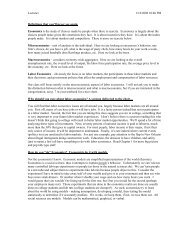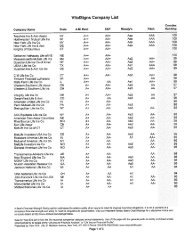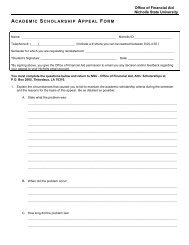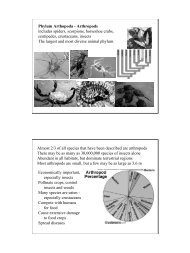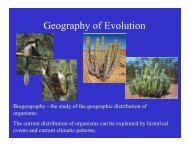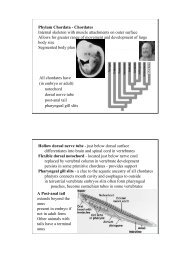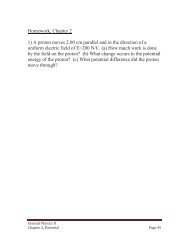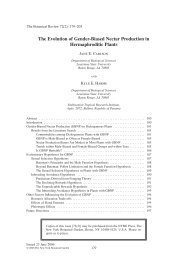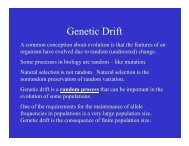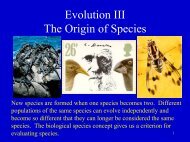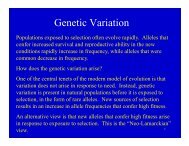Create successful ePaper yourself
Turn your PDF publications into a flip-book with our unique Google optimized e-Paper software.
<strong>Plant</strong> <strong>Structure</strong> and Growth<br />
<strong>Plant</strong> body divided into root and<br />
shoot<br />
Shoot consists of leaves, buds,<br />
flowers, and stem<br />
Root consists of primary and<br />
secondary (lateral) roots<br />
Growth occurs at meristems<br />
Apical meristems of root and<br />
shoot allow for increase in<br />
length - primary growth<br />
lateral meristems allow for<br />
increase in girth (diameter) -<br />
secondary growth
<strong>Plant</strong> growth<br />
Primary growth occurs at root and shoot apical meristems
Root apical meristem is covered by protective root cap
Apical meristems give rise to<br />
primary tissues:<br />
protoderm- gives rise to epidermis<br />
procambium - gives rise to<br />
primary vascular tissue<br />
(primary xylem and phloem)<br />
ground meristem - gives rise to<br />
parenchyma<br />
Lateral meristems produce secondary<br />
growth:<br />
cork cambium - produces cork<br />
cells of outer bark<br />
vascular cambium - produces<br />
secondary vascular tissue<br />
(secondary xylem and phloem)
<strong>Plant</strong> tissue types<br />
ground tissue - thin walled parenchyma cells in interior of root and<br />
shoot - which function in storage, photosynthesis, and secretion<br />
often capable of giving rise to other tissue types<br />
dermal tissue - covers entire plant body (more detail later)<br />
vascular tissue -<br />
xylem - for conducting water and dissolved minerals<br />
phloem - for conducting carbohydrates and other substances<br />
necessary for plant growth
Secondary growth - only<br />
possible in woody plants<br />
produced by lateral meristems<br />
vascular cambium produces<br />
secondary xylem to the<br />
interior of the stem and<br />
secondary phloem to the<br />
outside of the stem<br />
cork cambium produces cork<br />
cells of bark as diameter<br />
increases
Dermal tissue<br />
epidermal cells originate from protoderm - covered by waxy cuticle<br />
in green shoots, young roots, and leaves<br />
specialized cells in the epidermis include guard cells and trichomes<br />
root hairs are extensions of individual epidermal cells
Ground tissue<br />
Parenchyma - irregularly shaped thin walled living cells that fill much<br />
of the interior of a root, shoot, or fruit<br />
Collenchyma - elongate living cells with thickened walls provide<br />
support for plant organs like leaves and stems without secondary<br />
growth - e.g. strings in celery<br />
Sclerenchyma - usually nonliving cells - cell walls reinforced with<br />
lignin<br />
fibers - long slender cells grouped together into strands that<br />
provide support - e.g. linen fibers from flax<br />
addition of fibers to wood makes wood “hardwood”<br />
sclerids - irregular shaped cells found in groups and serve to<br />
strengthen and protect - e.g. grit of pears
Vascular tissue<br />
Xylem : tracheids and vessel elements - both dead cells, lacking<br />
cytoplasm, attached end to end, for water and mineral transport<br />
tracheids are found in all vascular plants, vessels are only<br />
common in angiosperms<br />
vessels are more efficient conductors
Vascular tissue<br />
Phloem: consists of sieve tubes and companion cells, for transport of<br />
carbohydrates from areas of photosynthesis<br />
Sieve tubes have cytoplasm, and cell membrane, but lack a nucleus,<br />
and are maintained by companion cells (modified parenchyma cells)<br />
Sieve tube elements connected through sieve plate
Root structure:<br />
Developing roots have four regions<br />
Root cap - parenchyma cells that<br />
cover and protect tip of young rootsecretes<br />
mucilaginous substance, also<br />
functions to perceive gravity<br />
Zone of cell division - root apical<br />
meristem - dome of cells at center of<br />
root tip can divide every 12 to 36<br />
hours, gives rise to protoderm,<br />
procambium and ground meristem<br />
Zone of elongation - Cells become longer than wide by expansion<br />
of vacuoles, no further increase in cell size afterwards<br />
Zone of maturation - cells differentiate into specific cell types
Root structure:<br />
epidermal cells can develop root hairs as outgrowths<br />
cortex - parenchyma cells that can function in food storage<br />
endodermis - single layer of cells with cell walls impregnated with<br />
suberin - prevents water and mineral passage between cells -<br />
suberin band around cells is the “Casparian strip”<br />
Stele - all cells interior to the endodermis<br />
Pericycle - parenchyma just interior to the endodermis - can produce<br />
lateral roots and the root vascular cambium
Dicot roots have central core of primary xylem, arms radiate<br />
toward pericycle and phloem between arms<br />
Monocot xylem forms ring of vascular bundles surrounding<br />
central cylinder of pith<br />
Dicot Monocot
Root modifications<br />
Adventitious roots - arise along stem or locations other than base<br />
of plant<br />
Aerial roots - roots that extend out into the air, unconnected to the<br />
ground<br />
Prop roots - located on lower part of stem of some monocots like<br />
corn, grow down into ground, anchor against wind<br />
Pneumatophores - spongy outgrowths from underwater roots<br />
May extend above water, increase oxygen supply to roots<br />
Parasitic roots - penetrate host plants to parasitize them<br />
Food storage roots - branch roots of plants like sweet potatoes<br />
produce extra parenchyma cells for carbohydrate storage<br />
Buttress roots - produced by certain varieties of fig and tropical<br />
trees for support
Stem structure:<br />
Node - the region of leaf attachment<br />
Internode - stem area between nodes<br />
Leaves project from stem<br />
Blade: Flattened portion<br />
Petiole: Slender stalk supporting<br />
blade<br />
Axil - angle formed by leaf<br />
attachment to the stem<br />
Axillary bud is produced in<br />
each axil<br />
Axillary buds may develop<br />
into branches<br />
Terminal bud - produced at tip<br />
of stem<br />
Terminal buds extend length<br />
of stem
Dicot stems have vascular bundles arranged in ring around a core<br />
of pith - with primary xylem to the inside and primary phloem to<br />
the outside - vascular cambium is found between xylem and<br />
phloem<br />
Monocot stems have vascular bundles scattered throughout<br />
ground tissue - have no vascular cambium - so secondary growth<br />
is not possible
Secondary growth<br />
Vascular cambium produces secondary xylem to inside and<br />
secondary phloem to outside<br />
secondary xylem is wood and is added in sequential layers<br />
phloem is thin-walled and is older layers are crushed as new<br />
layers are produced and stem increases in girth<br />
Cork cambium arises in cortex and produces new cork to outside
Modified stems
Leaf structure
Leaf cellular structure<br />
Upper and lower epidermis covered by waxy cuticle<br />
Epidermal cells are nonphotosynthetic except for guard cells that<br />
surround stomata<br />
Interior cells are called mesophyll cells and are photosynthetic<br />
palisade mesophyll tightly packed under upper epidermis<br />
spongy mesophyll composed of loose cells above lower epidermis
Stomate and Guard Cells:<br />
Two guard cells surround the stomate<br />
cell wall thickened along stomate border - allows opening<br />
and closing of stomate with change in cell volume
Modified leaves<br />
Floral leaves (bracts) - brightly colored leaves that surround<br />
flowers and add to ability to attract pollinators -<br />
e.g. Poinsettias, flowering dogwood<br />
Spines - reduce water loss and protect against predators - e.g. cactus<br />
Reproductive leaves - leaves that form new plantlets and allow for<br />
asexual reproduction - e.g. Kalanchoe (AKA “leaf of life”)<br />
Insectivorous leaves - leaves that<br />
trap insects in order to<br />
digest and extract minerals<br />
that are in short supply<br />
otherwise - e.g. pitcher<br />
plants, Venus flytrap, and<br />
sundew




